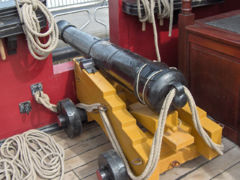Trunnion
A trunnion is a cylindrical protrusion used as a mounting point.
In a cannon, the trunnions are the two projections on the side of the barrel which mount the barrel in the carriage.
In steam locomotives, they are support gudgeons on either side of an oscillating steam cylinder. They are usually tubular and convey steam.
On communication satellites, the antennas are usually mounted on a pair of trunnions to allow the beam pattern to be correctly pointed on the Earth from the geostationary orbit.
On firearms, the barrel is sometimes mounted in a trunnion, which in turn is mounted to the receiver. This usage is common for tubular or pressed metal frame guns, such as the Kalashnikov, PPSh, Uzi, Sten, and others.
In older cars, especially those by the Triumph Motor Company, the trunnion is part of the suspension and either allows free movement of the rear wheel hub in relation to the chassis or allows the front wheel hub to rotate with the steering. On many cars the trunnion is machined from a brass or bronze casting and is prone to failure.
On stage lighting instruments, a trunnion is a bracket attached to both ends of a striplight that allows the striplight to be mounted on the floor. Sometimes trunnions are also equipped with casters to allow the striplight to be moved easily.
In aviation, the term refers to the structural component that attaches the landing gear to the airframe. For aircraft equipped with retractable landing gear, the trunnion is pivoted to permit rotation of the entire gear assembly.
Trunnion bearings
In avionics, these are self-contained concentric bearings that are designed to offer fluid movement in a critical area of the steering.
The term is also used to describe the wheel that a rotating cylinder runs on. For example, a lapidiary (stone-polishing) cylinder runs on a pair of rollers, similar to trunnions. The sugar industry uses rotating cylinders up to 6.7 metres in diameter and 40 metres long weighing around 1000 tonnes. These rotate at around 30 revolutions per hour. They are supported on a pathring which runs on trunnions. Similar devices called rotary kilns are used in cement manufacture.

